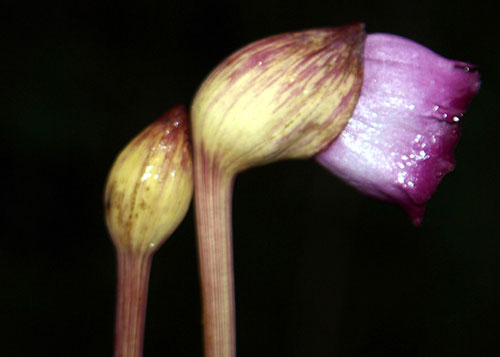Earlier in Aeginetia - The plant specialized in parasite
When the first rains fell into the tropical rainforest, the ginger family Zingiberaceae began to sprout, jubilantly. They do not know that tomorrow, they will have to back up uninvited guests, persistently cling to "suck blood".
>>>Chim tu hú - The silver mother and the assassin child
At the same time, the strong winds of the rainy season were enough to break the "sleeping" seed bag of the Aeginetia sp. Millions of tiny seeds in it begin to swirl along the water, then cling to the fragments of the ginger-dried plants and wait for the revival of a new life.
They will begin flowering, pollinating, leaving the next life to be able to adhere to decaying organic matter, the tissue of the ginger family Zingiberaceae, after part of the old ginger plant has completed its mission and From the world.

Earth ear press Aeginetia indica.(Photo: Phung My Trung )
The rains constantly help them with the fresh ginger, but it is enough to have the moisture maintained below the ground to help their aging parts rotting quickly. Just wait, the earliest Aeginetia sp. Start making tiny seeds germinate very quickly.
The scales are formed to grow against the original. Because chlorophyll cannot be produced and synthesized, the earmills only know how to live. When the roots grow long enough and strong, they attack the living cells of ginger and suck organic matter from their bodies as a "parasite" . Ginger trees began to struggle to feed their lives and feed the uninvited guest.
Not only the ginger family of Zingiberaceae, but the family Poaceae is also the host of the superior bum. The ear of the Aeginetia sp. It is not foolish to suck up all the nutrients from the host plant so that both of them die, which makes the host live, wilt and wear back to support them until they flower and pollinate.
So, throughout the life of the ear of the Aeginetia sp. just waiting. They expect the new rainy season to come, to thank the winds and hope that some stupid wild host species live near the water.
Because there are many medicinal properties in traditional medicine, the ear is being destroyed by humans for the purpose of making medicine. They are exhausted and the habitat of host species is also over-exploited by humans, making the life of this species more fragile.

Ear soil Aeginetia pedunculata.(Photo: Phung My Trung)
How to identify those who "eat beans" ? The ear-eared species, Aeginetia indica, is a smooth 3-6cm tall, non-branched, narrow, sharp-edged plant, located at the base of the stem, often growing. The flower-handle of the piece is 15-35cm tall and carries only one flower at the top. The flowers of the species usually bloom in August and September and give fruits in October-November. Plants often grow on grasslands and parasites on the Poaceae grass family, the ginger family Zingiberaceae at a height of 700-1.100m throughout Vietnam.
The ear of Aeginetia pedunculata lives mainly on plants of the Poaceae family, the ginger family Zingiberaceae and often lives at lower altitudes than the earlobes. They have a pale yellow body, the scales are sprouting, concentrated in the base and flower buds up to 15cm tall.
The title has been changed.
- The species of blood-sucking plants
- Almost lost his life because the parasite eats meat
- This photo is ravishing until you take a closer look to see a horror truth
- Women die earlier than men because of bladder cancer
- Fukushima nuclear plant lost power due to ... mouse
- The genome of the malaria parasite is decoded
- Dangerous and bizarre parasites
- Monkey is the reason why people go to the forest to get malaria
- 25,000 East-dwelling parasites on every Christmas tree
- The whole parasite parasites in the human eye for more than 1 year
- 'Aggressive' drug-resistant malaria parasites spread throughout Southeast Asia
- The parasite in the bug bugs sucks blood that has been spread through mice
 Why do potatoes have eyes?
Why do potatoes have eyes? 'Tragedy' the world's largest carnivorous life: Death becomes ... public toilet
'Tragedy' the world's largest carnivorous life: Death becomes ... public toilet Tomatoes were once considered 'poisonous' for 200 years
Tomatoes were once considered 'poisonous' for 200 years Detecting microscopic parasites on human face
Detecting microscopic parasites on human face